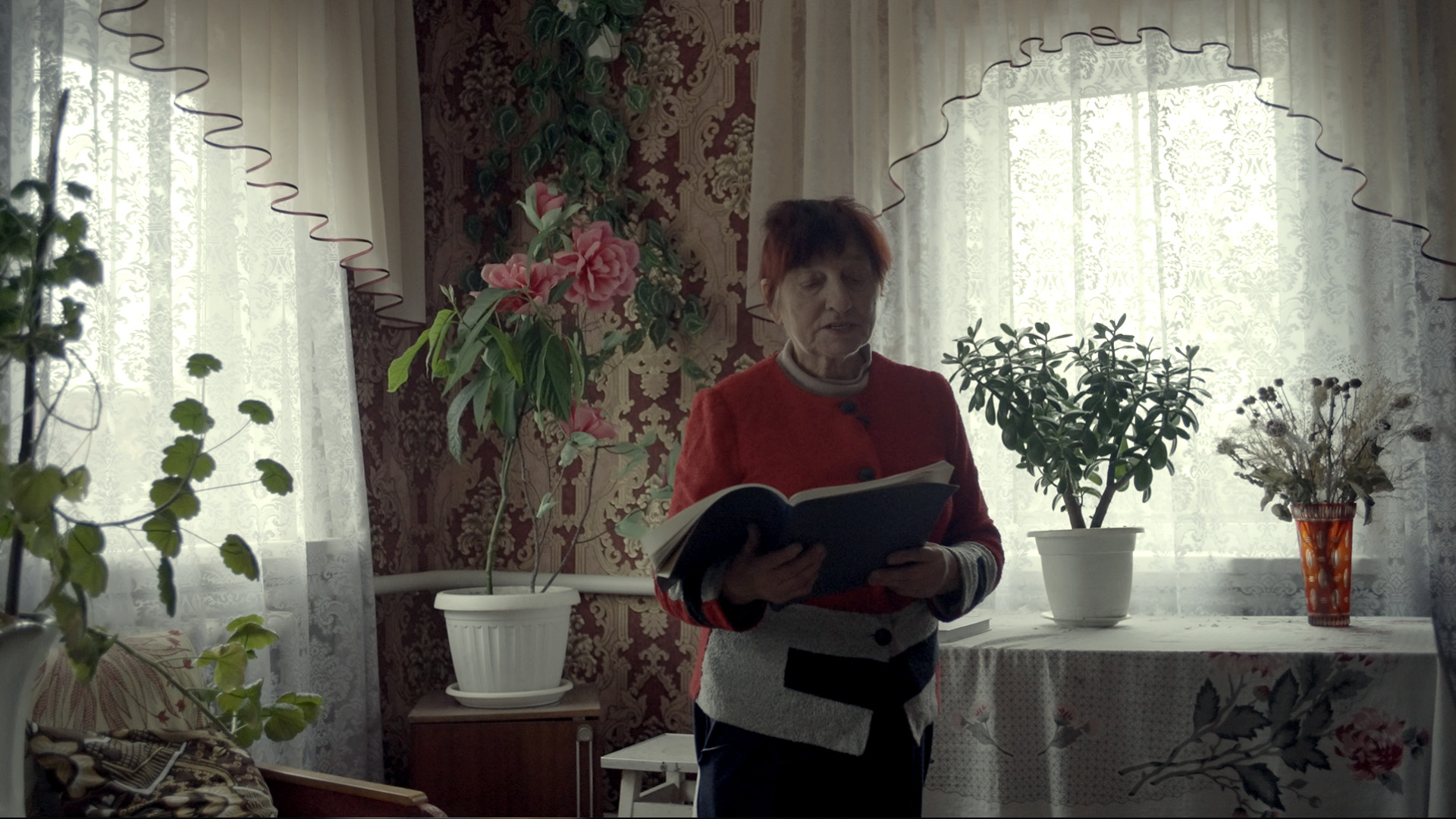Ukrainian documentary filmmaking is the cinema of a newly acquired sense of community. We are an ancient yet newly awakened tribe of Europe, still learning to speak with one voice. But this voice can no longer be silenced or ignored.
Any text written about Ukraine today inevitably touches on the war. Every film made in Ukraine over the past decade is evaluated on a timeline that begins on 20 February 2014—the de facto start of Russia’s invasion.
What is cinema during wartime? Is it only about the war? The war has now entered its 11th year, having begun the moment Russian troops in Crimea left their designated bases, broke all agreements, and began seizing government buildings while blockading the Ukrainian forces still honoring their loyalty oath.
In Ukraine, war has not merely become a part of the social, political, and cultural landscape—it has been shaping this landscape for a long time, even if we did not fully recognize it before.
Within the vast body of cinema produced in Ukraine over these years, documentary filmmaking seems to me the most distinctive. The societal awakening ignited by the Euromaidan protests catalyzed progress across all genres, yet documentary filmmaking, for evident reasons, underwent the most profound transformation. Both the quantity and quality of films have increased exponentially. At the same time, our film industry has finally opened itself to the world, with many productions now created in collaboration with major European film industries—from the Czech Republic to the United Kingdom, from Poland to France.
It all began with chronicles of the revolution, but what truly matters is that 2014 ushered in a new generation of filmmakers, fueled by fresh ideas, new perspectives, and a deep passion for their craft. The pinnacle of recognition for this “new wave” is the Oscar award for Mstyslav Chernov's feature-length debut, 20 Days in Mariupol. Over the past decade, though, Ukrainian films have consistently won awards at prestigious film festivals, and as we will see, not all of them focus on war or revolution.
Still, it is important to consider the narrative these diverse directors follow. How do they portray Ukrainian ethos and identity?
When it comes to the foundational socio-cultural practices of Ukrainians, the first thing that comes to mind is anarchy—not so much as the absence of government postulated by Kropotkin and Bakunin, but as a form of horizontal self-organization within society. The first anarchist formation on Ukrainian soil was undoubtedly the Cossack Sich—a free Cossack settlement with an elected leader, the ataman, who could be removed at any moment. The world’s first anarchist republic—the Makhnovist Movement, with its capital in Huliaipole—was also declared in Ukraine.
The saying “In any unclear situation, organize a Sich” from the Euromaidan period is only partly a joke. Both Maidan uprisings—in 2004 and in 2013–2014—were indeed organized according to the Sich principle, with self-defense units in the hundreds, a high level of mutual aid, and self-organization. It is from such a perspective, grounded in this inherent feature of Ukrainian society, that one should approach the examination of post-Maidan documentary filmmaking.
One of the first notable films of the new Ukrainian wave is undoubtedly Ukrainian Sheriffs by Roman Bondarchuk (Ukraine-Latvia-Germany, 2015) which received a special prize at the Amsterdam IDFA festival.
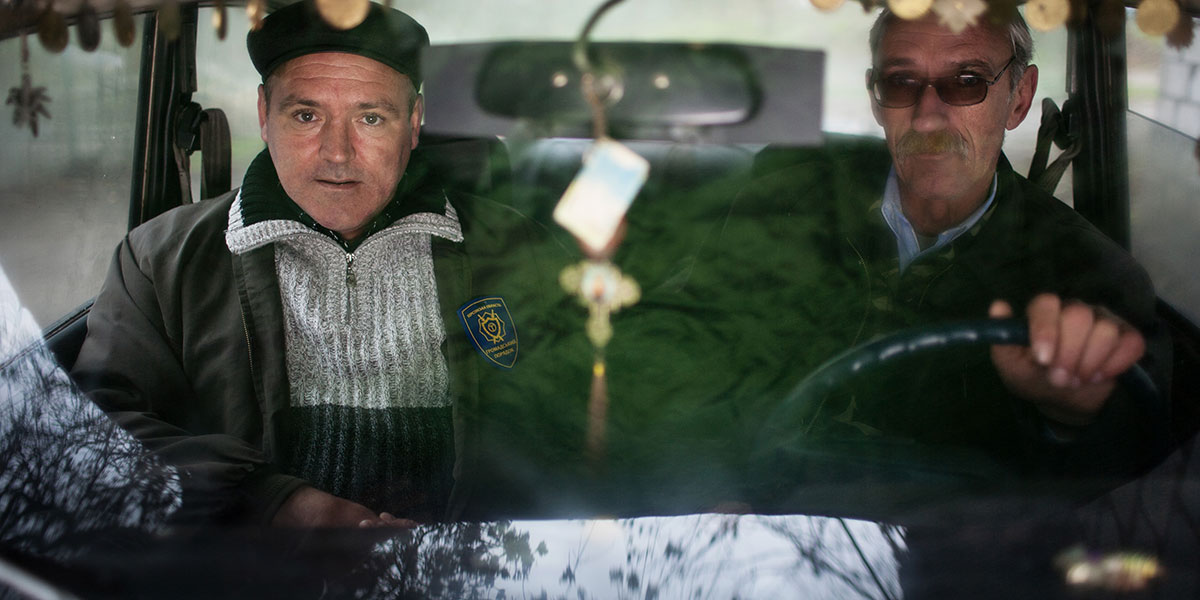
It is noteworthy that this film began as part of a human rights project, New Heroes, dedicated to individuals who effectively resisted the corrupt state apparatus. One such hero was Viktor Maruniak, the head of Stara Zbur’ivka, a village in the Kherson region, and a history teacher by training. Among other things, he shared with Roman the unique experience of hiring special sheriffs by the local community to maintain order.
The village appointed sheriffs because the local policemen, burdened with responsibility for a vast area, paid little attention to Stara Zbur'ivka. The sheriffs are named Viktor and Volodymyr. They are quite different, even opposite in character, yet carry themselves with confidence, embodying the role of “real men.” They drive around in their striking, cinema-ready canary-yellow Zhigulis. Together with headman Maruniak, they interact with an incredibly colorful array of locals; this kaleidoscope of Zbur'ivka faces is captivating.
However, the film is not so much about the sheriffs as it is about the southern Ukrainian village, burdened with both typical and uniquely local problems and a distinctive atmosphere. Bondarchuk does not chase provincial exoticism. He is primarily interested in the people of this village—whether funny or pathetic, touching or distressed. The director lived alongside his characters, blending into their world with his camera. The result is an extraordinary naturalness in the characters and a compelling narrative, worthy of the best examples of narrative cinema.
Bondarchuk’s second feature-length documentary, Dixieland (Ukraine-Latvia-Germany), was released at the end of 2015, but it has a longer history. It began as a short film, Polina, about a girl who plays in a children's jazz orchestra in Kherson; this sketch evolved into a full-length film over three years. The film features three main characters: Polina, a teenage trumpet player named Roman, and the new orchestra conductor, known simply as Lyova—who took the position after the death of the orchestra's founder, Semen Rivkin.
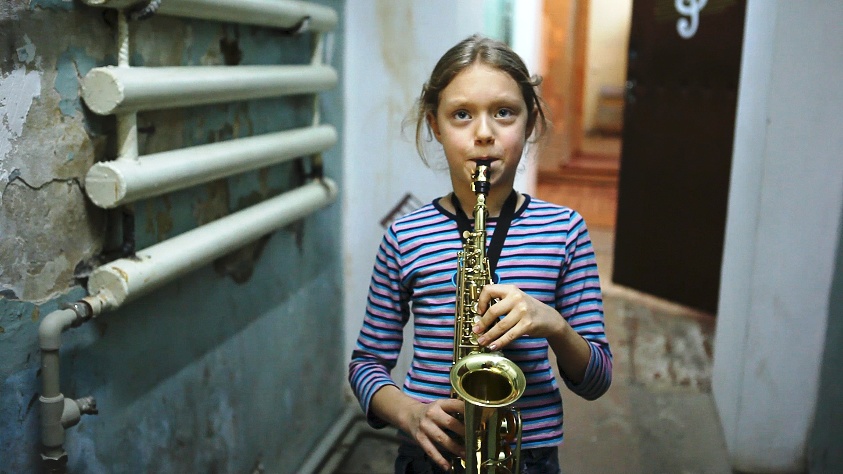
Dixieland follows a fairly traditional style, featuring excerpts from private film archives, observational footage, and a soundtrack. However, Bondarchuk handles this style with confidence. By depicting familiar realities—widespread poverty, the interiors of Khrushchyovka apartment blocks, Saint George’s ribbons, and the Victory Day marches on 9 May under red flags—he highlights the celebration of music. The film is filled with unscripted, musically cinematic moments that create an audio-visual framework for the vividly portrayed characters.
Ukrainian Sheriffs and Dixieland form a documentary diptych, a dual portrait of Kherson’s local community from both adult and child perspectives, as well as on both everyday and artistic levels.
In her feature debut The Earth Is Blue as an Orange (Ukraine-Lithuania, 2020, winner of the Best Director award at the Sundance Film Festival's World Documentary Competition), Iryna Tsilyk narrows the perspective to the confines of a family household. Tsilyk tracks the life of a large family in Krasnohorivka, a Donbas town that is constantly under shelling (since the start of the full-scale war, this place has been practically wiped off the map by Russian occupiers). For Anna Hladka who raises four children—Myroslava (“Mira”), Nastya, Vladya, and Stasyk—war is an especially heavy burden.
Myroslava is preparing to enter the film department at the National University of Culture while simultaneously making a film about her family's life, involving relatives, neighbors, and even Ukrainian soldiers.
Anna and her children live in defiance of the horror and absurdity that have engulfed Krasnohorivka over the past six years. “War is emptiness,” says Myroslava. Yet, in their home, they laugh, film, make music, and play with cats and a turtle that appears in the most unexpected places. They also hide together in the basement—not to escape shelling, but for a reenactment of how they survived it. Myroslava’s devotion to cinema is the kind of passion that moves mountains. The town, with its bullet-riddled walls, serves as an eloquent backdrop, fully utilized by Myroslava. As co-authors, Anna and her daughter constantly argue about the best way to shoot. For them, cinema is both a way of remembering and a form of therapy; it silences the war as much as it archives it. The films of Tsilyk and Myroslava mirror each other; the war resonates in their work, and everything is reflected in the eyes of the witnesses who are hostages of war. This is why Tsilyk turns the lens away from the footage of Myroslava’s material after the title “2014” and focuses exclusively on the eyes of the viewers—and these say more than enough to understand everything about Krasnohorivka and its people. These amazing women, young and old, who should not even be here, still are—by their very existence, they refute the madness of war. Similarly, through their voices, Myroslava and her resilient family become the true narrators.
Solidarity and mutual aid have been most vividly expressed through volunteering, which has been a core part of the Ukrainian resistance since the first day of Russia's full-scale aggression. This is exactly the message of Poem for Little People by Ivan Soutkin (Ukraine-Lithuania-United Kingdom, 2024). The film develops via two parallel storylines. The first tells the story of a group of volunteers and their leader, Anton. Their work involves evacuating civilians, especially the elderly, from frontline zones. The challenges they face are not only shelling, landmines, and artillery explosions, but also the stubbornness of the people. Many find it extremely difficult to leave the homes where they have spent their entire lives. Sometimes, evacuation has to be carried out under direct fire.
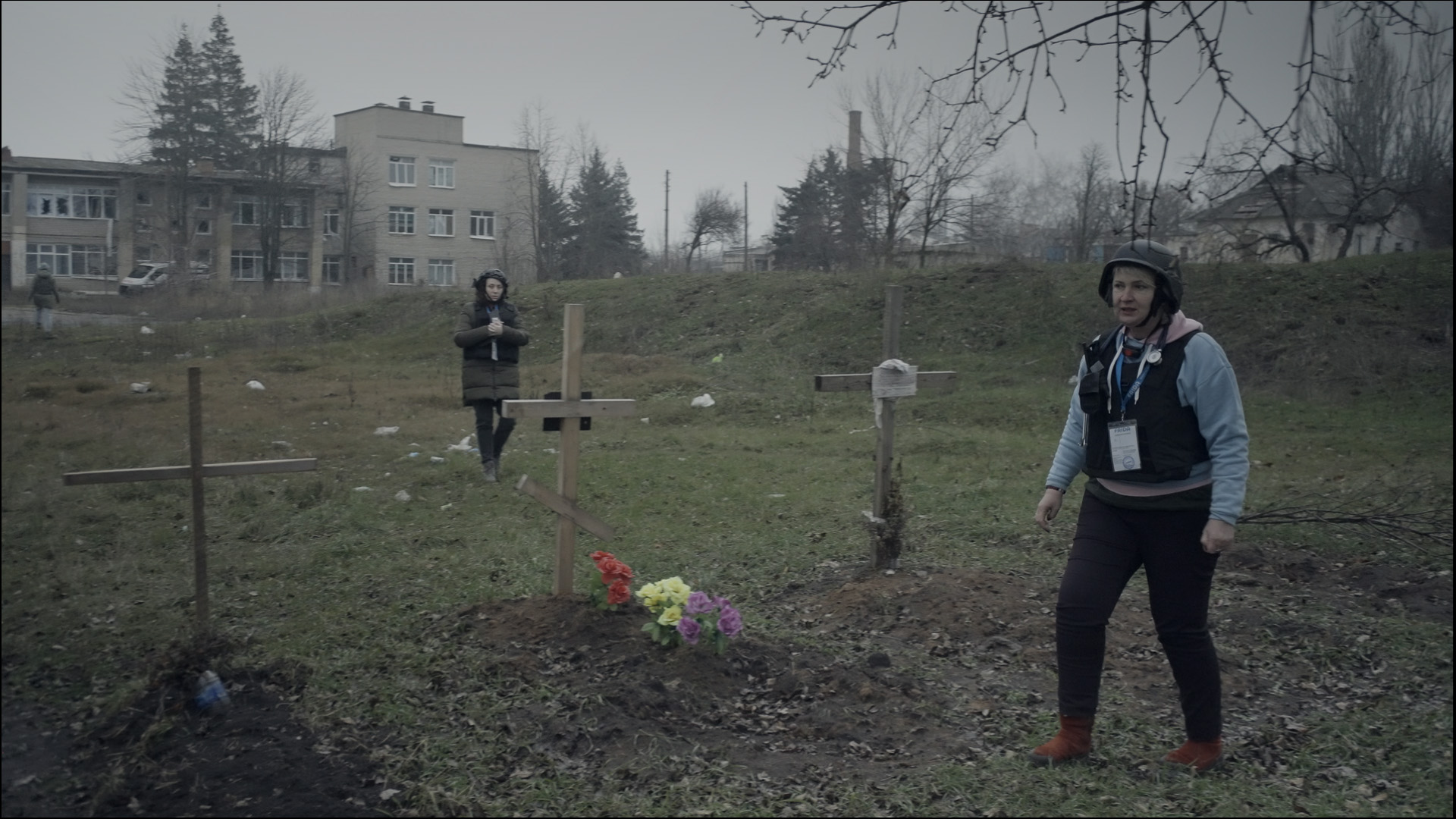
The second story follows two elderly friends from a recently liberated village in the Chernihiv region, pragmatic Zinaida and dreamy Taisia, who chose to stay home during the occupation. Zinaida and Taisia look for any form of resistance they can manage, from prayer and writing poetry to hiding historical memorial plaques and passing on intelligence to the Ukrainian military.
The intertwining of these two storylines gives A Poem for Little People its tension and poetic quality. At the same time, Ivan Soutkin avoids battle scenes and the depiction of violence. This is truly a film about ordinary people upon whom the full weight of war has fallen.
This overview would be incomplete without exploring the opposite end of the community spectrum—a sense of detachment, whether chosen or forced. Here, it is impossible not to mention two very different films.
The project This Rain Will Never End (directed by Alina Gorlova, Ukraine-Latvia-Germany-Qatar, winner of Best Feature Film in the “Best First Appearance” category at the IDFA Festival, 2020), previously known within the professional community as Between Wars, took nearly four years to complete. The film’s protagonist, Andriy Suleyman, a son of a Syrian Kurd and a Ukrainian woman, is depicted in black and white, with the narrative broken into chapters—from 0 to 9 and then back to chapter 0. Andriy fled the war in Syria for his mother’s native region of Luhansk, only to find himself caught in another war. We follow him as he volunteers with the Red Cross along the frontlines, visits relatives in Germany and Iraq, and attempts to bury his prematurely deceased father in his homeland. Ultimately, his sense of belonging leads him to increasingly difficult dilemmas: He cannot abandon his land, yet helping his new homeland, Ukraine, is equally an ethical necessity for him.
This is why this deeply personal chronicle unfolds against a civilizational backdrop, portrayed by the director as an endless cycle of suffering and resistance, a traumatic loop with no boundaries—this rain truly cannot be stopped.
Relatives by Vitaly Mansky (Ukraine-Germany-Latvia-Estonia, Best Documentary at the Karlovy Vary Film Festival, 2016) is an intensely personal film about the director’s relatives who experience the events surrounding Russia’s aggression in Ukraine in different ways. Mansky, a Soviet, Russian, and Latvian documentary filmmaker of Ukrainian descent, born in Lviv, has never forgotten his historical homeland. While making Relatives, which he narrates in Ukrainian, Mansky visited Lviv, Odesa, Kyiv, Sevastopol, and Donetsk from spring 2014 to spring 2015. His mother, aunts, nephews, grandfather, and cousins all live in Ukraine. They all have different professions, life views, and political beliefs. The director gives each of them a voice and often appears in the frame himself—a quite risky technique for a documentary filmmaker—while avoiding making direct judgments. He tells not the story of finding those to blame, but rather the tragedy of his own family, where loved ones—citizens of the same country—became complete strangers.
The theme of combat remains the most important one. Among other works about the Ukrainian military, Eastern Front (directed by Yevhen Tytarenko, Vitaly Mansky, Ukraine-Czech Republic-Latvia-USA, 2023) stands out for its masterful portrayal of the lives of five Ukrainian soldiers in both wartime and peacetime. Co-director and protagonist Yevhen Tytarenko initially went to the front as a documentarian, but later enlisted as a volunteer in the Hospitallers Medical Battalion. Almost all of the footage was shot by Tytarenko and his brothers-in-arms using mobile phones and body cameras. Two contrasting streams of imagery dominate: the frontlines and the home front. As Yevhen and his comrades advance toward the front, they send their families to a quiet village in western Ukraine. They return to this peaceful refuge only for a few days to visit their loved ones and baptize the son of one of the soldiers.
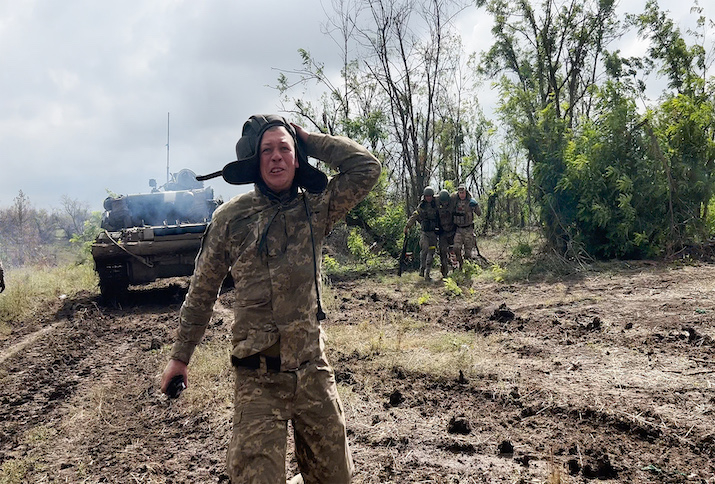
All five heroes are vivid personalities, each in their own way. However, the contrast between a person in uniform and one without is not merely about appearance—it creates a completely different mood, rhythm, and language. The scenes in the rear mostly consist of lengthy dialogues about everything under the sun—the politics of Russification, sperm banks as a way to preserve the genetic material of soldiers, miraculous pregnancies, ideological battles with relatives, and various tricks (for example, with a medical diagnosis) to avoid mobilization and being sent to the frontlines. They also depict services in a small church, swims in a pond on a sunny day, feasts under the open sky, and flocks of birds at twilight.
The frontlines, on the other hand, are filled with the dissonance of artillery fire, salty jokes, and strong language. The earth is torn up by trenches and pockmarked by explosions, creating different circles of hell. One of the soldiers even says, “It’s like purgatory,” upon arriving at a farm where dozens of cows, stuck in the mud, are slowly dying. Yet, the disturbing fragments are balanced by peaceful landscapes, with situational and graphic humor existing in both worlds. Thanks to skillful editing, Eastern Front exudes an exceptional poetic quality.
By highlighting five individuals among the hundreds of thousands who are currently holding the frontlines, Tytarenko and Mansky have accurately recreated the model of combat brotherhood: It is not just a military rank but a sense of existential kinship that helps withstand the fiercest of enemies—and this special closeness, this collective spiritual effort, is somehow inherent in the heroes and heroines of Ukrainian Sheriffs, Dixieland, The Earth is Blue Like an Orange, and A Poem for Little People.
Ukrainian documentary filmmaking represents a cinema of a newly discovered community. Whether denied or embraced, viewed as an external concept or experienced as an inherent quality, it is sometimes comical, often tragic, occasionally confined to the most intimate circles, but always present. We are an ancient yet simultaneously new European tribe, still learning to speak with one voice, but this voice is already impossible to silence or ignore.
Text by Dmytro Desiateryk; Translated by Kate Tsurkan; Film stills courtesy of the directors
This article came out of the collaboration between the IWM and the Polish online magazine Dwutygodnik. It was first published in Ukrainian and Polish.
Dmytro Desiateryk is a Ukrainian film critic and cultural journalist. He regularly writes on topics of Ukrainian cinema and culture for Ukrainian and international media. He is also member of FIPRESCI, European and Ukrainian Film Academies, and voter of the 80th and 81st Golden Globes.

